 |
||
|
||
| ||
Intel, a leader on the processor market, gave birth to its latest child, Pentium 4, quite a lot of time ago. A funny and even ugly suckling turned into a handsome youth in a year. And Intel decided to find a couple for its child among its partners. But the result wasn't perfect as the tests of the i850 and i845 boards showed. Soon VIA suggested that the Pentium 4 make friends with its P4X266 chipset. However, guileful Intel decided to bring an action against VIA. Board makers, thus, had to stop supplies and refuse marking boxes with the brand names.In particular, it concerns one of the boards which will be tested today - probably its developer's name starts with S. Major manufacturers are afraid of losing Intel's favor; other companies, however, have been putting their names on the boxes and boards fearlessly. But I still don't think the situation is so terrible for giants. VIA has recently declared founding a subdivision to deal with production of motherboards under its own trade mark. It seems that VPSD (VIA Platform Solutions Division) is going to hold a record as far as the number of models on one chipset is concerned... By the way, VIA is now developing a lot of new chipsets for the Pentium 4. The court examination, however, is not finished yet... Well, let's study then what we have now: and today there are 4 motherboards on the VIA P4X266, one on the i850 and one on the i845. Participating mainboards
SL-85DRV (VIA P4X266 PR22-S)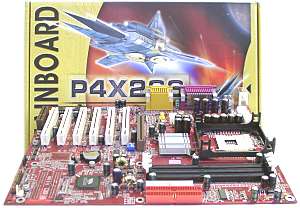 The board and the box do not indicate the manufacturer, but the marking and some peculiarities of the BIOS are typical of the famous vendor "S". In general, I don't think this board will be a long-liver - one of the newly released boards of VIA VPSD is PR22-S which is identical to the board in consideration. To all appearances, "S" will resort to the manufacturer protection program created by VIA specially for the law suit against Intel concerning the P4X266. The box contains the board, a user's manual, ATA66/100 and FDD cables, an additional thermistor and a CD. Unfortunately, this CD much differs from those which are supplied with legally produced boards: the design is poor, the installer of drivers and software changed, all free programs disappeared. There are only drivers, a Boostek utility, Adobe Acrobat Reader 5.0 and several utilities for system monitoring. 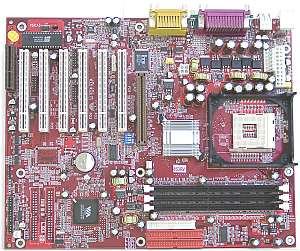 The board is of high quality, but the layout is not the best: connectors of additional USB ports and of a SmartCard reader are located between PCI slots, and a CD-in is put in front of the first PCI slot and an AGP one. This board serves a base for several versions as there is space for an IDE RAID controller and its connectors and for the second serial port. The board features 13 Low ESR capacitors of 2200uF each. Switches can help you clear the CMOS, enable/disable Suspend-to-RAM and permit/forbid records in EEPROM. The DIP switches are meant to change a FSB frequency. The BIOS is based on the v6.00PG Modular BIOS from Award. Apart from standard possibilities there is a great number of settings for memory timings, and for PCI and AGP buses modes. The board supports the SmartDoc Anti-burn Shield, one of the technologies of "S". Voltage supplied to the memory, AGP bus and processor can be changed, as well as the FSB frequency (in 1 MHz steps). Shuttle AV40R This board scores the best results in our tests. As it is a production sample it soon will be available on the shelves. A standard box houses a 80-page installation manual, a manual on the IDE Raid controller, 2 ATA66/100 and one FDD cables, 2 brackets with two USB ports each for the rear computer panel and a CD (drivers, manuals for the board and IDE Raid in .pdf and Adobe Acrobat Reader). 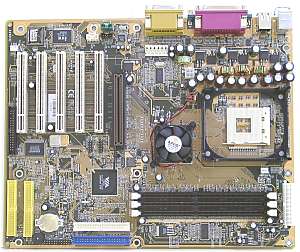 There are some drawbacks in the layout: IDE Raid connectors are behind the PCI slots, an FDD connector is tucked in between the board's edge and the last PCI connector, and audio-ins are located in front of the same slots. The USB 2.0 controller's chip is not unsoldered. There are also 16 capacitors of 1500uF and one switch which clear the CMOS. The BIOS is based on the v.6.00PG from Award and offers a wide range of settings for memory and an AGP bus, manual distribution of interrupts among PCI slots, changeable voltage supplied to the chipset, memory and core. You can also change a FSB frequency and a CPU multiplier. This board looks attractive; it offers quite a lot of functions and demonstrates a decent performance. ACorp 4VPX266A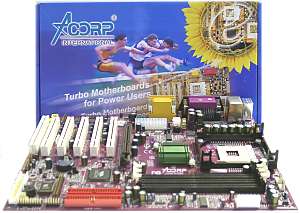 This board is one more evidence that ACorp does its best to extend its market. The first such attempt was made with the i845 based board, and now we have one more board of a unique color and with some peculiarities. As we have received only a preproduction sample there are not many accessories. A box of a typical design contains ATA66/100 and FDD cables and a CD-R. The latter comes with drivers and software which can be installed with a normal ACorp's shell. The programs are quite ordinary: Adobe Acrobat Reader, Norton Antivirus 2001, Norton Ghost, system monitoring utilities, AutoSave and eWalla programs, and a soft DVD WinDVD 2.6 player. 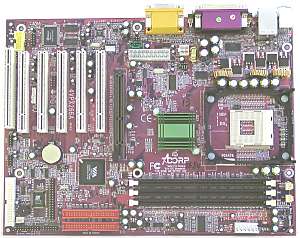 The board supports SmartPanel (v.I & II). It is a very interesting solution which is similar to the Asus iPanel but has a wider range of features (including connection of the second BIOS chip). As a result, the layout is not the best because of connectors of this solution. The network controller realized with the south bridge works quite rapidly. The board carries 12 capacitors - 10 of 2200uF and 2 of 1500uF. Moreover, there is a built-in speaker. With the switches you can clear the CMOS and implement some other usual operations. The BIOS is based on v6.00PG from Award where you can find a great heap of settings for memory, AGP and PCI buses and a possibility to adjust some registers of the chipset. The Vcore can be changed up to +0.275V and -0.1V relative to the rated value in 0.025V steps). The CPU multiplier is also changeable. In general, the board has a decent functionality at the moderate price; the tests will demonstrate how good this board is "afoot". Azza P4X2-AV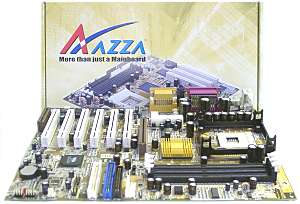 Azza (A - Aspire to Create, Z - Zeal for Technology, Z - Zest for Quality, A - Always to serve) is our rare visitor but since its foundation in 1989 it got several prizes. The yellow box that we received had only the board and a user manual in English. The normal box should have two cables: ATA66/100 and FDD, and 4 CDs which will come with drivers and plenty of software stuff including Linux Mandrake, Star Office and Virtual Drive. 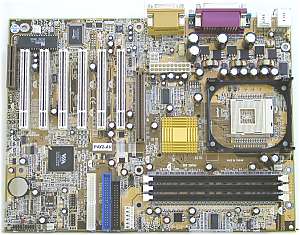 The layout is not very good: HDD and FDD connectors are behind the first three PCI slots, and it might be difficult to handle cables of these connectors when long cards are inserted. Audio-ins which are located in front of these slots are, thus, inconveniently positioned. This PCB serves a base for several boards on the VIA P4X266 chipset as there are unsoldered connectors for a Smart Card Reader, an IRDA port and front audio-outs. There is also space for a chip which realizes the Azza-Alarm technology (it informs you about problems appearing during the POST procedure). The board features 14 capacitors of 2200uF each but they do not provide the required stability. Overall, there are three switches: one is meant for clearing the CMOS, and with the others you can make your computer be able to turn on/off from keyboards and mice with USB or PS/2 connectors. The BIOS is based on the ver. Modular 6.00PG from Award. The wide range of memory settings goes with rich possibilities for adjusting AGP and PCI buses. Besides, you can change Vcore and a FSB frequency. I would have recommended this board if it hadn't hung so often. But I hope that this problem will be eliminated in production samples. MSI 850 Pro5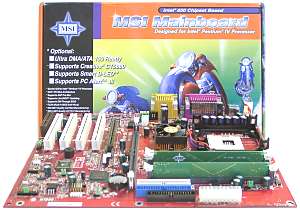 The board from the mobo giant is made on a red piece of textolite. It is interesting that one of the memory slots is turned at 90 degrees to the others. But the most intriguing is that such a large board houses only 4 PCI slots, though you will hardly a board of such format with less than 5 PCI slots. In the florid box we have found the following accessories: a detailed board's description, ATA66/100 and FDD cables, D-Bracket (a bracket with 2 USB ports and 4 LEDs for realization of the D-Led technology), a short description of the D-Led technology, 2 C-RIMM modules, a SmartKey with an extender and a CD. The latter contains drivers for motherboards and video cards from MSI, Adobe Acrobat Reader, AMI and Award utilities for working with the Suspend-To-Disk function, WinFlash from Award for updating of the BIOS right from Windows, proprietary programs such as LiveBIOS and Fuzzy Logic 3, a PC Alert for monitoring temperatures and fan speeds, GoodMem for deleting unnecessary programs from the memory, X-Setup, PCCillin 2000, 3Deep for adjusting a color balance and VNC (for a remote computer access). 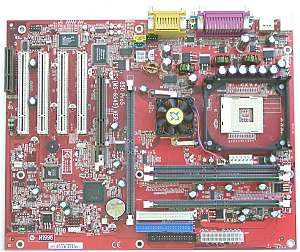 The layout has some imperfections: IDE and FDD connectors are placed too close to each other. There are 8 capacitors of 2200uF and 3 ones of 1500uF. It is interesting that there are two connectors for external USB ports instead of a traditional coupled one. When we first started the computer the fan refused to work, though there is not much need in it. We checked it and found out that it is the board that should be blamed. Besides, the board uses a 2Mbit BIOS instead of the standard 4Mbit one. There are several switches: for clearing the CMOS, FWH recording protection, for changing the memory voltage (2.5 (at default), 2.58 and 2.68V) etc. The BIOS based on the Award Modular BIOS 6.00PG. In our lab we use a preproduction sample of the Intel Pentium 4 with an unlocked multiplier that is why the first thing we decided to do was to set the required multiplier. At x20 the processor worked only at 1.9 GHz. At X21 everything was OK - 2 GHz. We obtained a new version of the BIOS from the company's site where they said the bug was fixed. But after installation of the BIOS 1.1 nothing changed... In all other respects, there is not much interesting in the BIOS: some memory settings, adjustable processor voltage and FSB frequency. This board has both advantages and downsides which you should take into account when choosing a candidate for your computer. DFI NB72-SR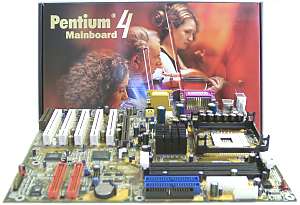 A standard box contains the board, a user's manual in English, French, German and Spanish, an installation manual for the IDE RAID, a diskette with drivers, ATA66/100 cables, an FDD one and a CD. The latter comes with drivers, a user's manual in .pdf, Adobe Acrobat Reader, Winbond Hardware Doctor and PCCillin 2000. 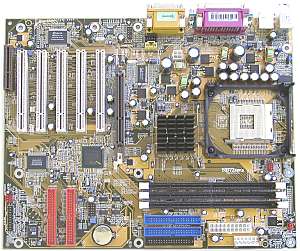 The soldering is of high quality, but there are some tiny drawbacks in the layout, for example, IDE Raid connectors are located behind the PCI slots - if full-sized expansion cards are inserted it is difficult to handle cables for these connectors. The board features 15 capacitors of 2200uF. There are several switches: one is for clearing the CMOS, two can help you start up the system with the PS/2 & USB devices; and the last one sets the basic FSB frequency - Auto, 100 or 133 MHz. The BIOS is based on the v.6.0 from Award and offers a wide range of settings for memory timings and an AGP bus, manual distribution of interrupts among PCI slots, unimpressive changeable multiplier and FSB frequency (in 1 MHz steps). It is a stable board which suits for a great deal of tasks - it is a bit cheaper than its competitors but has an excellent operating speed and plenty various functions. PerformanceTest system:
Software:
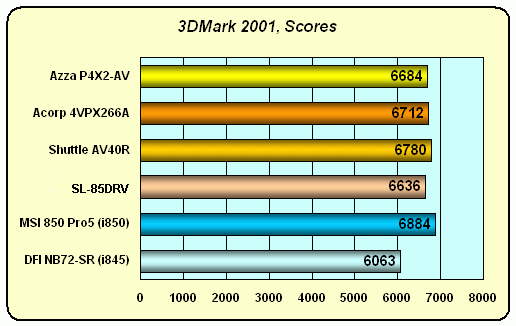 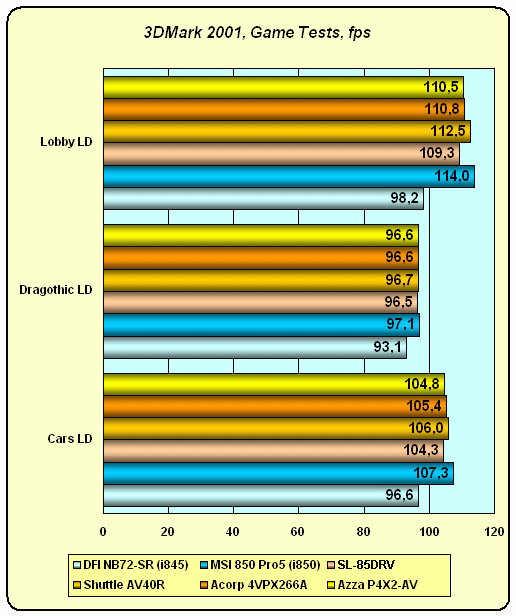 Both the total score of the 3Dmark and the results of separate tests arrange the boards according to the memory type used: MSI (i850, RDRAM) is above all, 4 boards on the VIA P4X266 with DDR RAM lag behind by 3-4%, the DFI (i845, SDR) falls behind by 8-10% more. The VIA based board perform very close, but Shuttle is still the first, while the Soltek comes the last.  Here the situation is absolutely the same, though the gap between the boards on the different chipsets has become larger.   The only thing that changes is again a gap between the boards: the MSI has a 5-6% lead on the P4X266, the P4X266 beats the DFI by 10-15%. All P4X266 are right about the same. 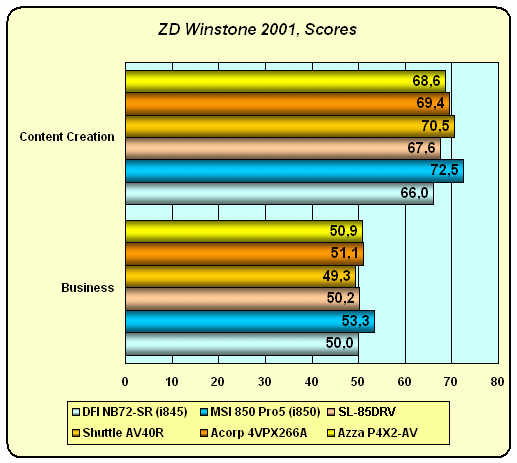 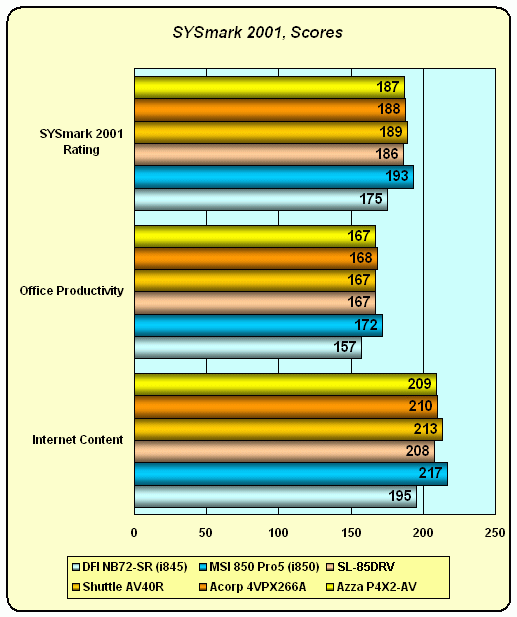 These applications remind me the figures of the 3Dmark, and only the Shuttle oddly falls into the last position in the ZD Business Winstone. I don't understand what has caused it, but I think inaccuracy of measurements is not the last thing to be taken into account.  It is the only test where VIA beats the i850. And this board is the Shuttle. 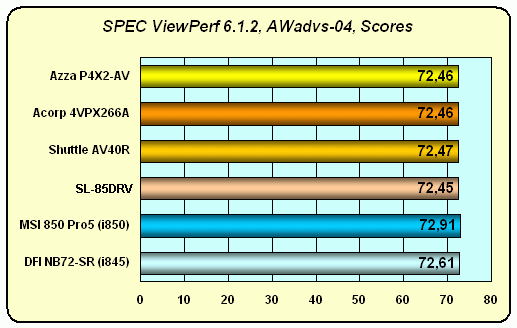 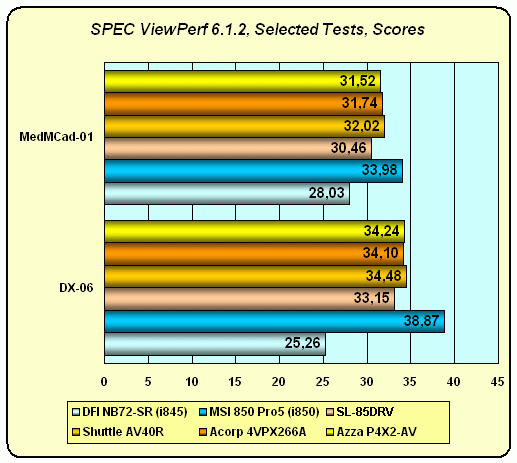 The AWadvs-04 gives the i845 one more chance to leave the last position, and the DX-06 shows how badly the Pentium4 needs a higher bandwidth of the PC133. ConclusionThere are no unexpected results. The Shuttle bears the palm being ahead by a couple of hundredths of fps. The SL-85DRV has the best potential as it falls behind by the slightest but constant margin. Nevertheless, the descriptions of the boards do not concern the price aspect, which, however, is not the least important (we mean the price of 'board+memory'): are you ready to pay a 5% higher price for speed superiority of the MSI with vague stability prospects? Another obvious solution is the DFI which is available at the same price but which lags behind by 10-20%. By the way, we haven't yet seen boards on the VIA P4X266 from VIA PSD. The experience shows that the scores as well as the quality and functionality can be even better. So, do you like this chipset from VIA for the Pentium
4? Soon we will be able to compare it with a new one from SiS...
Let's wait and see.
Write a comment below. No registration needed!
|
Platform · Video · Multimedia · Mobile · Other || About us & Privacy policy · Twitter · Facebook Copyright © Byrds Research & Publishing, Ltd., 1997–2011. All rights reserved. | ||||||||||||||||||||||||||||||||||||||||||||||||||||||||||||||||||||||||||||||||||||||||||||||||||||||||||||||||||||||||||||||||||||||||||||